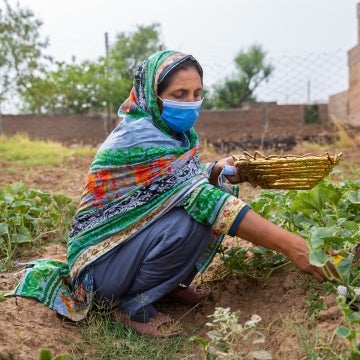|
Getting your Trinity Audio player ready...
|
One of the clearest messages from CGAP’s initial work on climate change is that there is significant reason to worry about growing climate risk undermining the noteworthy progress that’s been made worldwide on financial inclusion.
Today, CGAP can share early evidence from Pakistan that confirms our fears. Pakistan has been beset by climate impacts over many years, including devastating flooding in 2022, which heavily impacted the poorest households and the microfinance sector that serves them.
Inclusive finance in Pakistan has already pulled back from climate risk
CGAP worked with the Pakistan Microfinance Network (PMN) to survey inclusive finance institutions on how climate change has impacted their business over the last 10 years. The results are sobering. Respondents representing 69% of active borrowers and 74% of gross loan portfolio in the sector indicate that over the past decade, in response to climate change:
- 47% have reduced lending in a particular district/province, with 20% stopping lending completely. Notably, the most impacted provinces are Punjab and Sindh, which represent 90% of PMN members’ gross loan portfolio as of 2022.
- 40% have reduced lending to a particular sector, with agriculture and livestock/poultry as the most impacted sectors. This also has gender implications: while women in Pakistan have significantly lower labor force participation than men, the women who do work are more than twice as likely to be employed in agriculture.
Moreover, more than a quarter (27%) said that climate risks and events have meaningfully impacted their branch network. Half of them have closed branches permanently in climate-affected parts of the country, and half have scrapped plans to open new branches in those areas.
Needless to say, these are stark figures that will have real implications for the people in these sectors and regions left with less access to finance and fewer coping mechanisms.
It is worth underlining that these are qualitative findings from a self-reported survey in a single country. That being said, it is also a robust sample of the financial sector serving the most vulnerable populations in a country that has dealt with climate impacts for some time. As such, it should be considered an alarming bellwether for the inclusive finance community and those concerned with climate adaptation and resilience across low- and middle-income countries.
“Over 10-15 years, we have seen Pakistan impacted by climate, mostly in rural areas. This led to decreased lending in crop and livestock financing. The series of [climate] events has led to diversification of portfolio to reduce the risk as a long-term trend since the 2010 floods.” – Head of Operations, PMN
How can the inclusive finance community provide support?
These findings raise serious questions for the inclusive finance community in Pakistan and beyond. Have financial service providers (FSPs) in other markets started backing away from climate risk as well? If so, what actions can public and private actors take to bolster the resilience of FSPs to continue serving climate-vulnerable communities? CGAP has identified several key areas of intervention that are currently being explored.
1. Better risk management by FSPs
Financial institutions are increasingly undertaking climate risk assessments and stress tests to get a better sense of the vulnerability of their portfolios to climate change. However, this is often driven by requests from investors and regulators for risk reports rather than the needs of the business itself. Many financial institutions are not clear on what questions the assessments should be answering or how to translate them into tangible action. This makes managing climate risk harder, and simply retreating from vulnerable clients is the easy option as risk scores increase. Later in this blog series, CGAP will share our views on what questions FSPs should be looking to answer and which tools are best suited to each one.
2. Better support to FSPs
While they must urgently get better at managing climate risk, many FSPs will clearly also need help from funders and governments to keep serving vulnerable households as climate impacts grow. This includes:
- Better and more affordable solutions for risk transfer, such as portfolio insurance and reinsurance;
- For risk sharing, such as credit guarantees and first-loss capital, and
- For financing to develop and expand lending in new and untested solutions that support climate adaptation and resilience.
There are plenty of early examples showing the way, including climate-oriented funds by Oxfam Novib and Incofin as well as meso-level solutions like Vision Fund’s Ardis or a new World Bank fund for the resilience of Pakistan’s microfinance sector. CGAP will describe these solutions in a forthcoming blog and will shortly also publish a working paper on how public actors can build more climate-resilient and -responsive financial systems.
3. Better products for clients
Ultimately, the best way for financial institutions to reduce their climate risk exposure is to help clients reduce theirs. As CGAP previously reported, the industry has a long way to go in developing more climate-relevant solutions. While climate impacts and responses are both highly contextual, there are several categories of promising products that we will also describe later in this blog series, including contingent lines of credit, adaptive asset finance, and integrated climate insurance solutions. There is already much to build on, but far more innovation, learning, and scaling are still needed in this space.
Where does this leave financial inclusion and climate adaptation?
While these are findings from a simple survey in a single country, the clear retreat of inclusive finance in Pakistan from climate risk should spur reactions from proponents of both financial inclusion and climate adaptation. The findings could be considered an early warning and a call to action – climate change is already undermining financial inclusion, and reduced access to finance will make grassroots climate adaptation harder than it already is.
There is now a need for more and better data from other countries on the scale and speed of this withdrawal, but above all for a swift and determined effort to shore up the financial institutions that serve vulnerable populations facing climate impacts. In the following blogs in this series, CGAP will outline many of the pieces required and how stakeholders can get involved.



